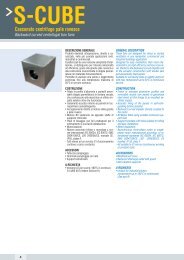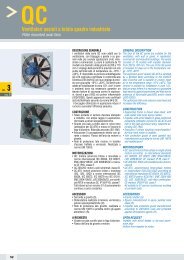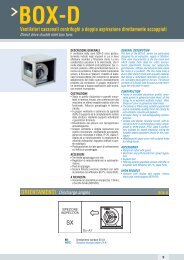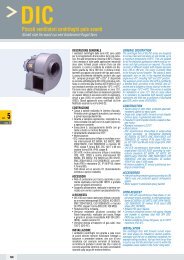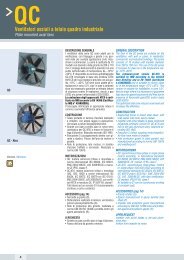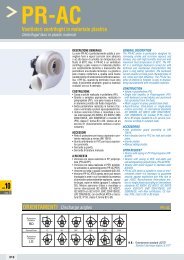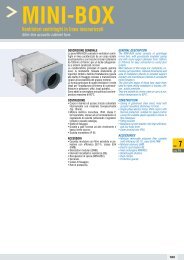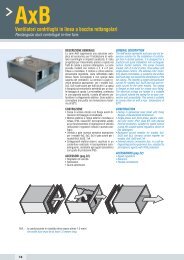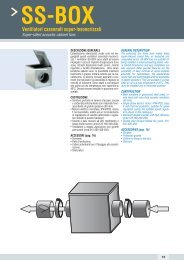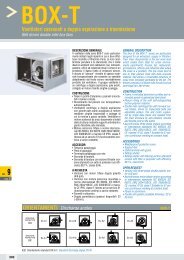GUIDA ALLA VENTILAZIONE DI AUTORIMESSE - Dynair.it
GUIDA ALLA VENTILAZIONE DI AUTORIMESSE - Dynair.it
GUIDA ALLA VENTILAZIONE DI AUTORIMESSE - Dynair.it
You also want an ePaper? Increase the reach of your titles
YUMPU automatically turns print PDFs into web optimized ePapers that Google loves.
<strong>GUIDA</strong> <strong>ALLA</strong> <strong>VENTILAZIONE</strong> <strong>DI</strong> <strong>AUTORIMESSE</strong><br />
Guidelines to car park ventilation
Ventilazione di Autorimesse: Principi & Soluzioni<br />
Car Park Ventilation: Principles & Solutions<br />
PRINCIPIO GENERALE<br />
Ventilare le autorimesse chiuse o sotterranee risponde a due esigenze<br />
fondamentali: rimuovere le sostanze inquinanti emesse dagli autoveicoli<br />
e, in caso d’incendio, mantenere sotto controllo i fumi e i gas caldi che si<br />
sprigionano, proteggendo le vie di fuga e facil<strong>it</strong>ando l’accesso alle squadre<br />
di intervento.<br />
TECNOLOGIA SPECIFICA<br />
Negli ultimi anni, la tecnologia dei ventilatori a getto e a induzione<br />
si è imposta come nuovo standard per la ventilazione normale e<br />
antincendio delle autorimesse.<br />
Essa rappresenta infatti l’alternativa più innovativa ed economica ai tradizionali<br />
sistemi di evacuazione meccanica in condotti. L’accurata gestione<br />
del progetto in tutte le sue fasi di sviluppo, che prevede il fondamentale<br />
ausilio di programmi di calcolo fl uido-dinamici, è inoltre garanzia di effettiva<br />
funzional<strong>it</strong>à del sistema.<br />
BASIC PRINCIPLE<br />
The ventilation of enclosed or underground car parks fulfi ls two key requirements:<br />
remove the pollutants em<strong>it</strong>ted by cars and, in the event of a<br />
fi re, control the hot fumes and gases produced by the fi re, protecting the<br />
escape routes and easing access for the emergency teams.<br />
SPECIAL TECHNOLOGY<br />
In recent years, the jet or induction fans technology has been<br />
established as the new standard for normal ventilation and smoke<br />
extraction in case of fi re in enclosed car parks..<br />
In fact, this technology represents the most innovative and cost-effective<br />
alternative to trad<strong>it</strong>ional ducted mechanical extraction systems.<br />
Carefully managing the project in all <strong>it</strong>s development stages, which requires<br />
the fundamental use of fl uid dynamics calculation programs, also<br />
ensures that the system is working correctly.<br />
CC-JD HT<br />
JET FAN Ventilatori assiali<br />
ad impulso per autorimesse<br />
JET FAN Impulse fans for<br />
car park ventilation<br />
CC-JC HT<br />
Ventilatori centrifughi ad induzione per autorimesse<br />
Centrifugal induction fans for car park ventilation<br />
Il sistema di ventilazione per autorimesse provvede alla rimozione completa dell’aria inquinata<br />
nei parcheggi sotterranei e/o all’estrazione dei fumi in caso di incendio. Su richiesta, può anche<br />
essere progettato combinando i due requis<strong>it</strong>i di ventilazione normale e antincendio: in questo caso<br />
specifi co si parla di sistema dual purpose.<br />
Car park ventilationsystem provides e<strong>it</strong>her normal ventilation and can also be provided for smoke<br />
extract in case of fi re in underground car parks, or a combination of both, i.e. a dual purpose fan.<br />
39
1<br />
Funzionamento Operation<br />
Il sistema integrato di ventilazione per autorimesse sviluppato da DY-<br />
NAIR® comprende tre elementi di ventilazione, dei sensori di rilevamento<br />
di CO (monossido di carbonio), un pannello di controllo e una analisi<br />
fl uidodinamica CFD: questi sono gli elementi essenziali per progettare il<br />
sistema di ventilazione più idoneo ad ogni specifi co parcheggio.<br />
Il sistema si basa sulla distribuzione lungo tutta la superfi cie del parcheggio<br />
di una serie di acceleratori assiali o centrifughi ad induzione i quali agiscono<br />
in modo simile ad un sistema di canalizzazione: installati a soffi tto, muovono<br />
l’aria dagli strati superiori verso il basso spingendola verso le zone di estrazione;<br />
creando un vero e proprio fl usso continuo d’aria, i VENTILATORI sono<br />
in grado di pulire a fondo l’aria degli strati inferiori e superiori del parcheggio,<br />
ev<strong>it</strong>ando la formazione di aree di ristangno.<br />
Completano il sistema di ventilazione, elementi di immissione di aria naturali<br />
o meccanici (rampa d’accesso al parcheggio, canali di ventilazione naturale,<br />
aperture laterali o ventilatori di immissione) ed elementi di estrazione (ventilatori<br />
di estrazione).<br />
40<br />
Si sviluppa un incendio<br />
A fi re starts<br />
CC SHT<br />
CC HT<br />
Ventilatore di estrazione della serie CC<br />
Exhaust fan - CC range<br />
Ventilazione normale esercizio<br />
Gli apparecchi a getto o induzione ventilano effi cacemente<br />
sia lo strato inferiore verso il pavimento che gli<br />
strati superiori verso il soffi tto, ev<strong>it</strong>ando la formazione<br />
di aree di ristagno. Entrano in funzione quando i<br />
rilevatori di CO (monossido di carbonio) rilevano un<br />
livello di inquinamento superiore alla soglia defi -<br />
n<strong>it</strong>a (che varia in funzione della tipologia del progetto e<br />
delle singole legislazioni nazionali).<br />
2 3 4<br />
Il sistema di ventilazione entra in funzione<br />
The ventilation system starts running<br />
Ventilazione in caso di emergenza<br />
Il sistema di ventilazione meccanica per l’evacuazione di fumi basato sui ventilatori a<br />
getto o ad induzione può essere facilmente organizzato in modo da essere ripart<strong>it</strong>o in<br />
aree di competenza ai fi ni di restringere gli effetti del fumo unicamente all’area interessata<br />
dall’evento. Ha il vantaggio infatti di mettere in sovrappressione i comparti antincendio<br />
e in depressione il comparto sede dell’incendio, impedendo la propagazione<br />
dei fumi; abbassa drasticamente la temperatura dell’ambiente coinvolto nell’incendio<br />
e inoltre non risente dei fattori climatici esterni (vento, pressione) o di fenomeni come<br />
i fumi freddi che tendono a ristagnare negli strati inferiori (ad altezza uomo).<br />
The fully integrated car park ventilation system developed by DY-<br />
NAIR® includes three ventilation elements, some CO (carbon monoxide)<br />
detection sensors, a control panel and a CFD analysis: these are<br />
the essential requirements to design the most su<strong>it</strong>able ventilation<br />
system for a specifi c car park.<br />
The system is based on placing a set of axial impulse fans or centrifugal induction<br />
fans all along the parking area, which operate in a similar way to a ducted<br />
system: when installed on the ceiling, they move the air from the top layers to the<br />
bottom layers towards the exhaust areas; by effectively creating a continuous<br />
air fl ow, the fans are able to thoroughly cleanse the air at the bottom and the<br />
top layers of the car park, avoiding the creation of areas where air gets trapped.<br />
The fans system is completed by air inlet devices operated by natural air<br />
or mechanical devices (parking access ramp, natural ventilation ducts, side<br />
openings or inlet fans) and exhaust fans.<br />
Normal ventilation<br />
The jet or induction fans effectively ventilate both the<br />
bottom layer, near the ground, and the top layers, near<br />
the ceiling, avoiding the creation of areas where air<br />
gets trapped. The fans are only operated when the<br />
CO (carbon monoxide) detectors detect a level of<br />
pollution higher than the preset threshold value<br />
(which varies according to the type of project and local<br />
legislation).<br />
I fumi di incendio vengono estratti<br />
The fi re smoke is exhausted<br />
Smoke extract in case of emergency<br />
The mechanical fume extraction ventilation system based on jet or induction<br />
fans can easily be spl<strong>it</strong> into control areas in order to reduce the effects of<br />
fumes only to the area affected by the event. This system, in fact, has the<br />
advantage of causing the overpressure of the fi re fi ghting sections and the<br />
underpressure of the s<strong>it</strong>e of the fi re, stopping the fumes from spreading; <strong>it</strong><br />
drastically reduces the temperature of the area affected by the fi re and is not<br />
affected by external weather cond<strong>it</strong>ions (wind, pressure) or events like cold<br />
fumes that tend to lag in the bottom layers (at human height).<br />
CC SHT<br />
CC HT
Benefi ci Benef<strong>it</strong>s<br />
Rispetto ad un sistema di ventilazione canalizzato<br />
l’innovativo sistema basato sui ventilatori<br />
a getto o a induzione genera molteplici benefi ci<br />
in termini di economic<strong>it</strong>à e di effi cienza inerenti<br />
a progettazione, all’installazione, al funzionamento<br />
e all’utilizzo.<br />
PROGETTAZIONE<br />
Ottimizzazione degli spazi grazie agli ingombri<br />
ridotti dei ventilatori e alla loro fl essibil<strong>it</strong>à di<br />
installazione sia nelle costruzioni ex-novo sia<br />
negli interventi di rinnovo e/o messa a norma;<br />
Risparmio di tempo di progettazione in quanto<br />
non va previsto e studiato un complesso sistema<br />
di canalizzazione;<br />
Effi cacia del sistema misurabile grazie alla modellazione<br />
CFD (analisi fl uidodinamica);<br />
Maggiore assistenza e servizio di pre-vend<strong>it</strong>a<br />
da parte del costruttore;<br />
Valutazione economica preliminare del progetto<br />
entro 24 ore;<br />
Costi fi nali in linea con i costi attesi.<br />
INST<strong>ALLA</strong>ZIONE<br />
Eliminazione di costosi e complessi sistemi di<br />
condotti e griglie;<br />
Facil<strong>it</strong>à di installazione dei ventilatori che garantisce<br />
un notevole risparmio in termini di ore/<br />
lavoro;<br />
Il ridotto ingombro dei ventilatori facil<strong>it</strong>a l’installazione<br />
di altri impianti (rete sprinkler, illuminazione ecc.);<br />
Facil<strong>it</strong>à di manutenzione ordinaria e straordinaria.<br />
FUNZIONAMENTO<br />
Importanti economie di esercizio derivanti<br />
dalla peculiar<strong>it</strong>à del sistema:<br />
Possibil<strong>it</strong>à di ventilazione parziale o solo se<br />
necessario: i rilevatori di CO (monossido di carbonio)<br />
e i sensori di fumo assicurano infatti che<br />
siano attivati solo i ventilatori nelle aree in cui<br />
sono stati superati i livelli di inquinamento o in<br />
quelle in cui si è innescato l’incendio;<br />
Minore potenza globale necessaria grazie a una<br />
progettazione accurata che garantisce un ottimale<br />
dimensionamento dell’impianto di ventilazione; in<br />
particolare, i ventilatori di immissione e estrazione<br />
possono essere di dimensioni minori in quanto i<br />
ventilatori a getto o a induzione generano una perd<strong>it</strong>a<br />
di carico trascurabile rispetto ai sistemi canalizzati.<br />
UTILIZZO<br />
Migliore qual<strong>it</strong>à dell’aria respirabile: il sistema crea<br />
un fl usso dinamico in grado di mescolare i vari<br />
strati dell’aria e di eliminare le zone di ristagno;<br />
Sicurezza ottimizzata in caso di incendio:<br />
l’estrazione rapida ed effi cace dei fumi tossici<br />
permette di proteggere al meglio le vie di fuga,<br />
di facil<strong>it</strong>are l’accesso alle squadre d’intervento,<br />
di favorire l’incolum<strong>it</strong>à delle persone e di minimizzare<br />
gli effetti dell’incendio sulle strutture<br />
dell’edifi cio.<br />
Compared to a ducted ventilation system,<br />
the innovative based on jet or induction fans<br />
system ensures multiple benefi ts in terms of<br />
low cost and effi ciency associated w<strong>it</strong>h <strong>it</strong>s<br />
design, installation, operation and usage.<br />
DESIGN<br />
The compact size of the fans allows to optimise<br />
the spaces and their fl exibil<strong>it</strong>y of installation<br />
both when building new properties or refurbishing<br />
and/or certifying existing buildings;<br />
It saves design time as <strong>it</strong> does not require a<br />
complex ducted system to be designed and<br />
implemented;<br />
The system effectiveness can be measured w<strong>it</strong>h<br />
CFD (fl uid dynamics calculation) modelling;<br />
It allows the project designer to benefi t from a<br />
better pre-sales customer service.<br />
The project can be fi nancially assessed w<strong>it</strong>hin<br />
24 hours;<br />
Final costs are in line w<strong>it</strong>h expected costs.<br />
INST<strong>ALLA</strong>TION<br />
It removes the need for costly and complex ducted<br />
and grilled systems;<br />
The fans are easy to install, ensuring time saving<br />
in terms of hours of work;<br />
The reduced size of the fans easies installation of<br />
other systems (sprinklers, lighting etc);<br />
Ease of scheduled and breakdown maintenance.<br />
OPERATION<br />
Major savings in running costs ensured<br />
by the system distinctive features:<br />
Ventilation can be fully or partly operated: the<br />
CO (carbon monoxide) detectors and the smoke<br />
sensors, in fact, ensure that only the ventilators<br />
located in the areas where pollution levels are<br />
exceeded or where a fi re has started are enabled;<br />
Less total power required as the accurate design<br />
ensures the optimal size of the ventilation system;<br />
more specifi cally, the inlet and exhaust fans can<br />
be smaller as the jet or induction fans generate a<br />
negligible pressure drop compared to ducted systems.<br />
USE<br />
Better qual<strong>it</strong>y of breathable air: the system creates<br />
a continuous airfl ow able to mix the different<br />
layers of air and to avoid areas where air<br />
gets trapped;<br />
Optimised safety in the event of a fi re: fast and<br />
effective toxic fume extraction, leading to safer<br />
escape routes, easier access for the emergency<br />
teams, promoting people safety and minimising<br />
the effects of fi re on the building structures.<br />
41
42<br />
Strumenti e Servizi System design and services<br />
D<strong>ALLA</strong> PROGETTAZIONE AL SERVIZIO AL CLIENTE<br />
La progettazione di un sistema di ventilazione per autorimesse implica lo studio dei problemi di fluidodinamica ad esso inerenti. Come noto, i<br />
calcoli relativi al moto dei fluidi sono estremamente complessi: effettuarli manualmente accresce il rischio di errore, compromettendo il corretto<br />
funzionamento del sistema di ventilazione ideato e, di conseguenza, la salute e la sicurezza degli utilizzatori.<br />
In questa fase fondamentale della progettazione, DYNAIR® è in grado di offrire un importante e reale supporto ingegneristico grazie all’esperienza<br />
maturata negli anni e all’alto livello di preparazione dello staff tecnico che padroneggia l’utilizzo del Software CFD (Computational Fluid<br />
Dynamics), uno strumento evoluto di analisi fluidodinamica computazionale.<br />
FROM DESIGN TO CUSTOMER SERVICE<br />
Designing a car park ventilation system requires assessing issues associated w<strong>it</strong>h fluid dynamics. The high complex<strong>it</strong>y of fluid dynamics calculation<br />
is well known: manual calculation increases the risk of making mistakes, compromising the correct operation of the ventilation system<br />
designed and, therefore, users' health and safety.<br />
During this crucial design stage, DYNAIR® is able to offer a real and valuable engineering support thanks to the experienced and highly skilled<br />
technical staff, who boasts an in-depth knowledge of the CFD software, an advanced computational fluid dynamics calculation tool.<br />
COME FUNZIONA<br />
L’analisi CFD è essenziale per assicurare che tutte le aree del parcheggio<br />
siano ventilate correttamente e che, in caso di incendio, l’estrazione dei fumi<br />
avvenga in modo ottimale. Inoltre, è necessaria per definire il preciso dimensionamento<br />
del sistema di ventilazione e il corretto posizionamento dei ventilatori<br />
a getto o ad induzione e altri ventilatori di estrazione e/o immissione.<br />
Tale analisi si basa su una simulazione che integra variabili quali il numero di<br />
ricambi/ora necessari (defin<strong>it</strong>i dalla legislazione specifica ad ogni paese), il volume<br />
e la direzione dell’aria e le caratteristiche strutturali di ogni singolo parcheggio<br />
(in modello 3D). I dati elaborati generano degli scenari dinamici basati<br />
sui profili di veloc<strong>it</strong>à dell’aria, sul moto delle particelle e sulla distribuzione dei<br />
flussi di aria. Ne risulta un progetto finale fatto su misura. Questo metodico<br />
processo consente non solo di misurare l’effettiva efficacia del sistema, ma<br />
anche di garantirne l’ottimizzazione da un punto di vista economico in quanto<br />
si ev<strong>it</strong>ano progetti sovra-dimensionati.<br />
HOW IT WORKS<br />
CFD calculation is essential to ensure that all areas of the car park are<br />
correctly ventilated and, in the event of fire, fume extraction is optimised.<br />
It is also required to establish the accurate size of the ventilation system<br />
and the correct pos<strong>it</strong>ioning of the jet or induction fans and of other exhaust<br />
and/or inlet fans.<br />
This calculation is based on simulation, combining variables such as the<br />
required number of air changes/hours (established by local legislations),<br />
air volume and direction and structural features of each car park (in a<br />
3D model). The processed data generate dynamic scenarios based on air<br />
speed profiles, particle movement and airflow distribution. This allows a<br />
customised solution to be produced. This methodical approach ensures<br />
not only to assess the system effectiveness, by also the most cost-effective<br />
solution as over-sized projects are avoided.<br />
REALIZZAZIONE DEL MODELLO 3D DEL<br />
PARCHEGGIO E DEI SUOI VARI COMPARTI<br />
A questo livello dell’analisi sono note solo<br />
le condizioni geometriche e matematiche<br />
imposte al modello (condizioni al contorno del<br />
sistema).<br />
3D MODELLING OF THE CAR PARK AND<br />
ITS <strong>DI</strong>FFERENT SECTIONS<br />
At this level of calculation, only the<br />
geometrical and mathematical cond<strong>it</strong>ions<br />
required by the model are known (bounding<br />
cond<strong>it</strong>ions of the system).
Strumenti e Servizi System design and services<br />
SCENARIO FINALE<br />
In questa ultima fase avviene il controllo fi nale dell’effi cacia del sistema.<br />
SISTEMI AUSILIARI <strong>DI</strong> CONTROLLO<br />
ANCILLARY MONITORING SYSTEMS<br />
IMPOSTAZIONE DELL’ANALISI E ELABORAZIONE DEGLI SCENARI<br />
Introduzione delle condizioni al contorno e delle condizioni iniziali quali pressione esterna e<br />
temperatura dell’aria immessa dall’esterno; settaggio di tutti i parametri strutturali (bocche<br />
di lupo, rampe di accesso...) e impostazione delle condizioni di funzionamento (defi nizione<br />
materiali, assegnazione della curva delle prestazioni aerauliche al modello dei ventilatori);<br />
defi nizione della meshatura (quant<strong>it</strong>à di volumi prim<strong>it</strong>ivi in cui suddividere il modello).<br />
Elaborazione dei dati e valutazione di ogni scenario variando tipologia, quant<strong>it</strong>à e posizionamento<br />
dei ventilatori.<br />
ANALISI DEI RISULTATI E SVILUPPO <strong>DI</strong> UNA SOLUZIONE <strong>DI</strong> EQUILIBRIO<br />
Lo sviluppo dell’analisi può essere fatto verifi cando le veloc<strong>it</strong>à dell’aria all’interno dei singoli<br />
comparti del parcheggio. I grafi ci riportati rappresentano l’andamento della veloc<strong>it</strong>à media di<br />
attraversamento dell’aria su un piano di sezione.<br />
CALCULATION SET-UP AND SCENARIO DEVELOPMENT<br />
Introduction of boundary cond<strong>it</strong>ions and in<strong>it</strong>ial cond<strong>it</strong>ions such as external pressure and outside<br />
air temperature; structural parameter set-up (light wells, access ramps...) and operating<br />
cond<strong>it</strong>ions set-up (material defi n<strong>it</strong>ion, assignment of air performance curve to the fan model),<br />
mesh defi n<strong>it</strong>ion (quant<strong>it</strong>y of primary volumes the model must be spl<strong>it</strong> into).<br />
Data processing and assessment of each scenario by changing the type, quant<strong>it</strong>y and pos<strong>it</strong>ion<br />
of the fans.<br />
ANALYSING THE RESULTS AND DEVELOPING A BALANCED SOLUTION<br />
The data can be analysed by checking the air speed inside each section of the car park.<br />
The graphs shown below represent the average air speed on a sectional fl oor.<br />
FINAL SCENARIO<br />
During this last stage, system effectiveness is put to the test.<br />
DYNAIR® si pregia di assistervi con competenza ed esperienza<br />
in ogni singola fase di un progetto di ventilazione per autorimesse.<br />
DYNAIR® is able to assist you w<strong>it</strong>h <strong>it</strong>s know-how and experience<br />
during each stage of the ventilation project for car parks.<br />
DYNAIR® stabilisce, in fase di progettazione, la logica di comando dei sensori CO (monossido di<br />
carbonio) più adeguata ad ogni evenienza, al fi ne di migliorare l’effi cienza del sistema di ventilazione e<br />
la sua compartimentazione. <strong>Dynair</strong> propone un sistema completo di sensori CO in grado di rilevare la<br />
concentrazione di monossido di carbonio tale per cui venga necessario lavare il volume d’aria interessato.<br />
At the design stage DYNAIR® establishes the most su<strong>it</strong>able CO (carbon monoxide) sensor control logic for<br />
any eventual<strong>it</strong>y, in order to improve the ventilation system effi ciency and <strong>it</strong>s sectioning.<br />
DYNAIR® offers a full range of CO sensors able to detect carbon monoxide concentration requiring the<br />
affected air volume to be cleansed.<br />
43
9CA1011 REV/03<br />
Maico Italia S.p.A. Via Maestri del Lavoro, 12 - 25017 Lonato del Garda (Brescia) Italia<br />
Tel. +39 030 9913575 - Fax +39 030 9913766<br />
Member of<br />
info@maico-<strong>it</strong>alia.<strong>it</strong><br />
www.dynair.<strong>it</strong><br />
Caratteristiche e dati tecnici possono variare senza preavviso, mantenendo inalterati i principali parametri funzionali dei modelli. Tutti i marchi c<strong>it</strong>ati sono di proprietà di Maico Italia S.p.A. Tutti i dir<strong>it</strong>ti sono riservati.<br />
Features and technical data can vary w<strong>it</strong>hout prior notice w<strong>it</strong>hout modifying the main functional parameters of the products. All trademarks mentioned are the property of Maico Italia S.p.A. All rights reserved.



